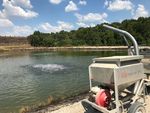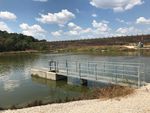Woodson Rearing Pond Woodson District Fisheries News Summer 2020 - KDWPT
←
→
Page content transcription
If your browser does not render page correctly, please read the page content below
Woodson District Fisheries News Summer 2020
Woodson Wildlife Area, 738 Fegan Rd., Toronto, KS 66777
https://ksoutdoors.com justin.l.morrison@ks.gov Office: 620-637-2748
Woodson Rearing Pond
The 2.5-acre channel catfish rearing pond below Woodson
State Fishing Lake is up and running again after being shut
down for a couple of years due to lake renovations. We
stocked 90,000 channel catfish 4-6” long on April 8 and
they will be taken out of the pond in mid-October. The goal
is to grow them to at least 8” because at that length
predation by largemouth bass drops dramatically. Usually
by the time harvest rolls around the fish are averaging
around 10-12” but some can be up to 15”. Starting off the
fish are fed 50 lbs. a day three days a week for about three
weeks. Then the feeding rate slowly increases as the size of
the fish increases. Eventually, we get up to 650 lbs. a day
for a week and then slowly taper the feeding rate back
down, and by harvest time they are only getting fedenough to maintain healthy body condition. Raising 90,000 fish in a 2.5-acre pond presents certain challenges through-
out the year including water quality problems, diseases, and parasite infestations. To maintain good water quality, the
pond is operated as a flow-through system which means water is constantly flowing through the pond keeping the water
as fresh as possible. The water is siphoned from the lake in a 4” line and a 6” line. When the lake is full, the 4” line can
run about 500 gallons/minute of water and the 6” line can run about 1400 gallons/minute, but as the lake level
decreases the flows decrease as well. During the summer if the weather remains dry the lake level can drop one foot in a
month. Even with a complete exchange of water every 1.5 days, the fish are prone to parasitic infestations, and to
prevent large outbreaks the fish are examined every two weeks by Farlington Hatchery Biologist Josh Jagels. Josh
examines gill tissue of 10-12 fish under a microscope and depending on how many parasites present he determines if
the pond needs to be treated. This year I have treated the pond three times using granulated copper sulfate at a rate of
0.5 parts per million. For the treatment, the water lines are shut-off, so the fish are exposed to the maximum dose for a
four-hour period. Generally, if the fish are treated, they are not fed that day because they do not feed well. Harvesting
the fish out of the pond is an extensive operation that requires a lot of manpower and about 2 days. Hatchery personnel
from all over the state and most Region 3 District Fisheries Biologist will be helping get the fish out of the pond and on to
trucks for stocking in various lakes in Eastern and Southeastern Kansas.
Springtime Electrofishing Survey Results
I was able to sample eight waterbodies this past Spring. The cool wet
weather made guessing the best sampling times a little challenging, but
overall, most of the samples were productive. Below is a table that
summarizes the results. Garnett North and South Lakes continue to be
some of my best bass lakes and Gridley City Lake seems to have turned the
corner and is now producing larger as fish over 4 pounds was sampled. The
population at Garnett Cedar Valley Reservoir may have declined slightly,
but good quality sized fish are still present and opportunities to catch
larger fish should still be good. Lebo City Lake currently has the lowest
density of largemouth bass in my district and is providing only fair fishing
opportunities currently. The largemouth bass populations in both Yates
Center lakes are remaining stable as the samples were like the previous
year.
Lake Total Catch Stock Length Fish/hr. # of 8-12" # of 12-15" # of 15-20" # of 20-25" Big Fish (lbs.)
Gridley City Lake 118 85 22 52 30 0 4.17
Garnett City Lake North 208 174 59 80 44 0 3.86
Garnett City Lake South 123 190 24 50 43 1 4.82
Garnett Cedar Creek Lake 96 45 28 36 23 0 4.15
Lebo City Lake 48 32 21 6 5 0 4.04
Yates Center South Owl 83 55 30 23 19 0 4.52
Yates Center City Lake 202 109 57 101 16 0 3.67Coffey County Lake We conducted two electrofishing surveys at Coffey County Lake during the Spring. One sample was conducted in March where we targeted only the warm water discharge looking for largemouth bass and the other sample was conducted in late April in which we focused on the rest of the lake. The March sample was productive as we captured 54 largemouth bass with the biggest weighing 5.05 lbs. However, the most surprising thing during that sample was the handful of smallmouth bass captured all weighing over 3 lbs. and the biggest was 5.20 lbs.! These fish were encouraging to see since the Largemouth Bass Virus has seemed to decimate both the largemouth and smallmouth bass populations. Low numbers of stock and sub-stock length largemouth and smallmouth bass were captured, further indicating the populations may still be struggling from the effects of the Largemouth Bass Virus. When we start seeing more sub-stock and stock length fish start showing up in the samples, I think we can then assume the populations are really starting to bounce back. Overall, these populations are still well below what they were a few years ago, and it is likely to take several years to come back from this population crash. Blue Cat Electrofishing Results John Redmond - I recently finished up my blue catfish sampling efforts at John Redmond. We used the electrofishing boat and an additional chase boat to sample. We captured 62 blue catfish in just under one hour of electrofishing. The sample was cut short when the chase boat broke down, but I felt that the data was enough for a complete sample. We captured 13 fish under 12” (these are considered sub-stock), 19 fish 12-20” (stock length fish), 26 fish 20-30” (quality length fish), 2 fish at 30” (preferred length fish), and 2 memorable length fish one at 35” and one at 37”. We ran into good schools of fish in the dredged area and was surprised to find the bigger fish in shallower water. It was good to see the four fish over 30” and I’m hoping with the implementation of the 35” length limit the number of bigger fish will increase. It is evident that the population is reproducing well as we continue to see sub-stock and stock length fish show up in the electrofishing and fall netting sample. It appears the current population is made up of quality length fish which ranges from 20-30” as they were the most abundant in the sample. I am planning to explore the use of juglines to target the larger fish and get a better handle on their abundance. Once the population becomes more abundant, and the size structure of the population shifts more towards larger fish, the length limit will be reevaluated and may be taken off or changed.
Coffey County Lake – We captured an all-time high of 171 blue catfish in 1.26 hours of electrofishing during our summertime electrofishing sample. This year’s sample did not result in as many big fish as we collected last year, however the number of sub-stock and stock length fish collected was encouraging to see and suggests some good year classes were recently produced. We captured 56 sub-stock fish (less than 12”), 60 stock length fish (12-20”), 39 quality length fish (20-30”), 12 preferred length fish (30-35”), and 4 memorable length fish (2 at 35” and 2 at 39”). According to the sampling data and exit creel data that is collected as anglers leave the lake, this population is in stable condition as the catch and harvest numbers have remained consistent over the past few years. This population is not considered a high-density population, but rather a moderate density population and it provides some quality fishing opportunities. Anglers catch 30lb.+ fish regularly and the recent Catfish Chasers tournament resulted in a five fish winning weight of 128 lbs. and the biggest fish weighed in was 47 lbs. Woodson State Fishing Lake The fishing at Woodson State Fishing is ramping up as the fish continue to grow. Anglers are experiencing great catch and release fishing for a variety of species including largemouth bass, sunfish species, channel catfish, and even some walleye are being caught. Besides bluegills and some redear sunfish, the other species that is producing harvest sized fish is channel catfish as there is currently a good abundance of fish in the 15-18” range which is perfect eating size for those of you who like fried catfish. The largemouth bass and walleye are still well below harvestable size as both species are averaging around 10” in length, however, both can be caught regularly on small lures and light line. It may be a few more years before Woodson State Lake is producing consistent numbers of harvestable size fish, but It will be worth the wait. In the meantime, if you like catching small fish on light tackle this may be the place for you. All content is copyright of Kansas Department of Wildlife, Parks, and Tourism and cannot be copied or distributed without permission from KDWPT.
You can also read

























































